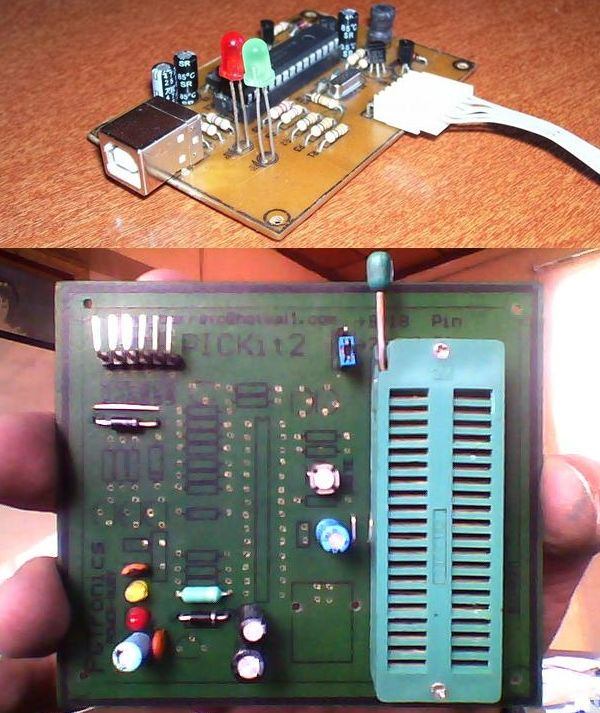

- #Pickit 3 clone diy install#
- #Pickit 3 clone diy manual#
- #Pickit 3 clone diy full#
- #Pickit 3 clone diy code#
- #Pickit 3 clone diy Pc#

#Pickit 3 clone diy full#
Which is to support full speed communication. The processor has a hinge PLL set to 96MHz which obtained by multiplying the 20 MHz crystal, USB own runs on 48MHz.
#Pickit 3 clone diy install#
He needs an integrated system HID driver, so no need to install another driver as the AVR programmer. The big advantage is that the CPU is right in itself contains a USB interface, so you can connect directly PC. The main element is a modern powerful PIC18F2550 processor, controls all activities of the programmer to communicate with the PC, write to the EEPROM, write to the programmed processor, etc. Below we describe the involvement and put into operation. The price is pretty high, unfortunately, moving it around and 600CZK, the main prize and two processor makes the EEPROM. I bought a transistor, the 16F2550 PIC and a few other things, resistors and fry the rest I bought from "us". Finally, I chose to use the original scheme, although it is quite complicated and the parts used in our country can not normally buy, but my problems with finding parts easily solved. And it also showed that becomes due to the switching inductance feta leave. On the Internet there are multiple versions of the programmer, it's usually cropped version of the log analyzer features, UART terminal, etc., 12V inverter is a modified version of it and control the MOSFETs, unlike bipolar transistors used in the original design.
#Pickit 3 clone diy manual#
Microchip released the schema directly in the user manual for the programmer. I chose between a couple of projects from different authors, but eventually won PICkit2. I wasn't sure how that was going to turn out but in the end, they've come a long way since I started with PIC in 2010.For a long time I needed a good programmer pussy, even if it is programming, so from time to time the application gets where it is used. I have to say I really love the direction Microchip has gone over the years, especially since they acquired Atmel. Maybe they'll add that in a future firmware release. I would love to see AT89S device support with the PK4. Once I learned that X and PK4 now support AVR devices, I wanted to give those a go. In 2015, I got into AVR devices using Atmel Studio and the AVR Dragon programmer. I was using the Hitech C Compiler until XC8 was released, which I really liked as it featured support for both Hitech PICC and C18 syntax. Eventually I started playing around with C here and there, then went into C full time. Microchip Assembly was my first programming language, followed by Intel Assembly with the MCS-51 family. I recently learned of some new 18F devices that I plan to try out. I messed with the 18F4620, 18F4550, and the 18F4555 before I found the 18F圆K22 family, which I have been using pretty much exclusively. When I transitioned to the 18F family, I bought the PICkit 3. From this point on, I used X exclusively and never looked back. It had improved immensely, and ICD was now fully functional. Once I realized the ICD didn't work very well, I went right back to MPLAB 8.92.Ī couple of years later, after X had been out for some time, I decided to give it another go. It was way cool at first and I loved the user interface, but very buggy. Needless to say, I ditched the old kit programmer. I especially loved the in circuit debugger functions. Once I had the PICkit 2, the convenience of editing code, then clicking the "Build & Load" button sped up my debug time immensely. I got back into playing with MPLAB IDE and got quite good with it. Once I transitioned to the 16F88x family, I bought a PICkit 2.

I had tried to wrap my brain around MPLAB IDE, but at the time I was very new to embedded electronics so it was a bit advanced for me at the time. I typically used Vim text editor, then MPASM assembler to build.
#Pickit 3 clone diy code#
I would have to remove the PIC from the target board and place it in the programmer for each code change.
#Pickit 3 clone diy Pc#
That was how I started back in 2010 with a 16F628A, but with a kit programmer that used a parallel port on the PC and the ICSP interface on the target.


 0 kommentar(er)
0 kommentar(er)
